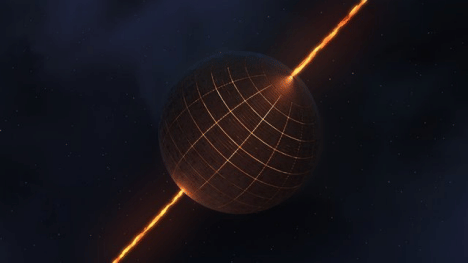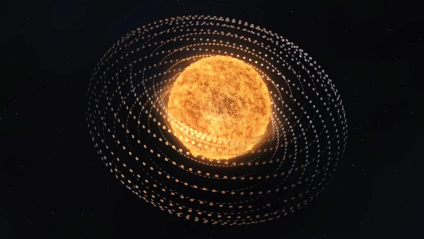Science
Dyson Spheres: A Badge Of Technical Superiority
C S Niranjana
Apr 11, 2022, 07:25 PM | Updated 07:25 PM IST
Save & read from anywhere!
Bookmark stories for easy access on any device or the Swarajya app.


Popular in science fiction, “Dyson spheres” are the dream of every starry-eyed engineer and physicist.
A Dyson sphere is essentially a huge structure that covers a star, captures a large amount of its solar output, and beams it to a receiving station.
It can be imagined as a solar panel, but instead of a roof or a field, it covers an entire star!
Popularised by British-born American physicist Freeman Dyson, it is a thought experiment that accounts for the high energy demand of an advanced civilisation.

Humans have always relied on energy in some form. We started with pure muscle, discovering fire, to using heat and steam. Then, moving through fossil fuels, solar, wind, and hydro power, we are now at the stage of harnessing nuclear power.
As we advance technologically, the energy requirement grows exponentially. Eventually, there will come a point when all of the power on Earth will not be sufficient.
So, where should we look?
The Sun, of course! It is 100 quintillion (18 zeros) more powerful than our most efficient nuclear reactor. What we receive as solar power in this age is a fraction of the fraction of the Sun’s radiation, which is 700 quadrillion (15 zeros) watts per year. The Sun shines with the energy of a trillion (12 zeros) nuclear bombs per second!
How Can We Make One?
Although the concept of a Dyson sphere was first formally introduced by Freeman Dyson (hence the name) in his paper Search for Artificial Stellar Sources of Infrared Radiation, he was inspired by the 1937 novel Star Maker by Olaf Stapledon. Dyson’s paper was focused only on the aspect of energy collection, not construction.
The Dyson sphere is often imagined as a hollow sphere of matter around a star, much like a shell. But it is almost mechanically impossible to construct a solid shell or ring around a star.
Alternatively, what was imagined was a loose collection or swarm of objects travelling in independent orbits — quite similar to the old model of an atom.
The swarm has different possibilities.
1. The original idea was a Dyson swarm — a large number of independent constructs orbiting in a dense formation. These swarms could be solar-powered satellites or space habitats.
This formation is useful as it can be constructed gradually. But the problem arises with the arrangement of orbits. It becomes increasingly complex to make sure that paths don’t intersect.

2. The challenge with the swarm can be resolved by a slight change in the idea and using Dyson rings instead — a large number of synchronised independent constructs wherein the structures follow the same orbit one behind another.

The efficiency increases as we add more rings to the star at slightly different orbits.

3. Similar to the swarm, there’s the concept of the Dyson bubble. It too consists of a swarm of independent objects but not in orbit. They are statite satellites suspended by light sails. This is a method of propulsion of spacecraft wherein the pressure of radiation emitted by the Sun on large mirrors is used. There would not be the danger of objects colliding or eclipsing one another. In fact, they will be stationary with respect to the star.
The distance can be varied with no effect to the output because the ratio of radiation pressure to the force of gravity would be constant.

Extraterrestrial Link?
It is statistically improbable to assume that we are the only living beings in the entire universe. If there are others and if they are advanced enough, we can detect their presence via Dyson spheres. Since the concept of these spheres is basic in nature, it is assumed that other civilisations can also come up with it on their own.
A Dyson sphere, after exploiting the massive energy of a star, would have to reradiate it away. Otherwise, it will build up and melt the entire structure. To a distant observer, the light from the star will seem dim based on how dense the material surrounding the star is. And at the same time, it will have a large amount of infrared radiation emitting from it. Hence, the presence of a Dyson sphere is a big billboard from a civilisation saying: “We are here and we are advanced.”
Are We Ready Yet?
The current energy consumption of the world is about 580 million terajoules per year. Which is about 94,804.34 barrels of oil equivalent (that is, the amount of energy found in a barrel of crude oil). That’s a large amount, but still manageable considering about 9,000 million terajoules of solar energy arrive at the surface of the Earth every day. A Dyson sphere, therefore, is not very crucial as of today. The energy needs will grow when we finally take the next big step — becoming a spacefaring civilisation.
Interstellar travel will require more energy than we can currently even imagine producing. It is then that we will need and develop the technology to build our very own Dyson sphere covering the Sun.
Can We Build One Anytime Soon?
Theoretically possible, yes, but it is currently beyond humanity’s engineering capabilities. The practicality of this mega structure using modern material science is questionable in this day and age but still not impossible.
For a Dyson bubble, we will need a material whose density is 0.8 grams per square metre. For comparison, that is a thousand times less dense than a regular sheet of printing paper! Currently, our lightest carbon fibre is of density 3 grams per metre squared, which is considerably thin but almost four times the required minimum.
Besides, the mass of such material, if we manage to manufacture it, needed to cover the Sun turns out to be 2.17 x 10 raised to the 21st power kilograms. Which is approximately equal to the asteroid Pallas!
We would also need an enormous budget and material to build, transmit, and maintain a Dyson sphere. The raw material will not be sufficient from Earth alone and will be very expensive, energy- and cost-wise. If we efficiently use the entire power resource on Earth, we will only be able to launch a mass approximately equal to that of Mount Everest to space, which is about 8 x 10 raised to the 14th power kilograms. A million times smaller than even the amount of material we will need.
Hence, the Dyson sphere will have to be made in space. We will need to set up bases in space to operate, assemble, launch, and transport parts at minimum cost. For the raw material requirement, we will have to disassemble entire planets and set up plants with automated maintenance. The best candidate would be Mercury since it is closest to the Sun and metal-rich.
Since human life is difficult to maintain in space, we will need automated robots to carry out constructions. To repair, maintain, and even expand to other stars someday, we will need self-replicating and self-maintaining robots.
There are a lot of factors to consider and several steps to take to get to a Dyson sphere, but perhaps in our lifetime, we may see a future wherein interstellar travel is as common as daily commute and Dyson spheres a norm.
This article has been published as part of Swasti 22, the Swarajya Science and Technology Initiative 2022. Read other Swasti 22 submissions.
Also Read: Freeman Dyson, The Genius Physicist Who Helped Bring Japan’s ‘Sacred’ Math To The World, Dies At 96
Niranjana is a major nerd. From water ripples to gravitational waves, she loves all things science. She's a recent science graduate. She also loves to dive into the bookish world of science fiction, mysteries, and psychological thrillers. She is really fond of her furry friends and loves to run!





